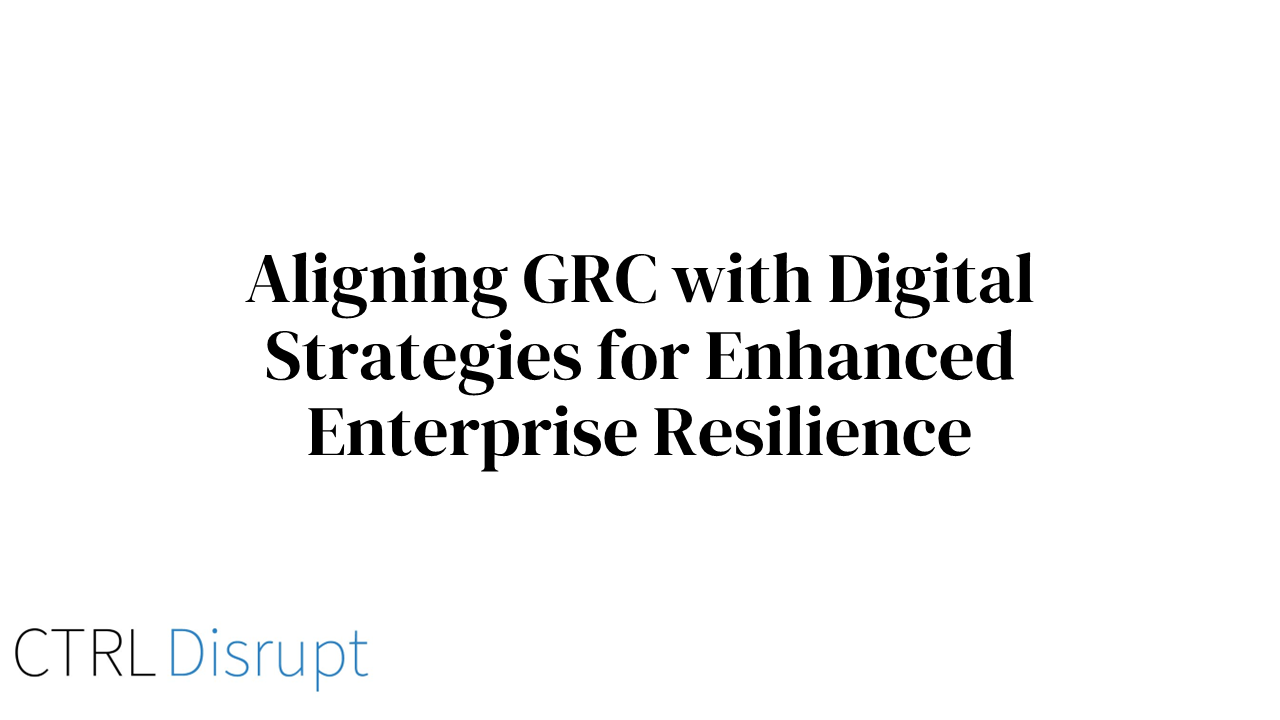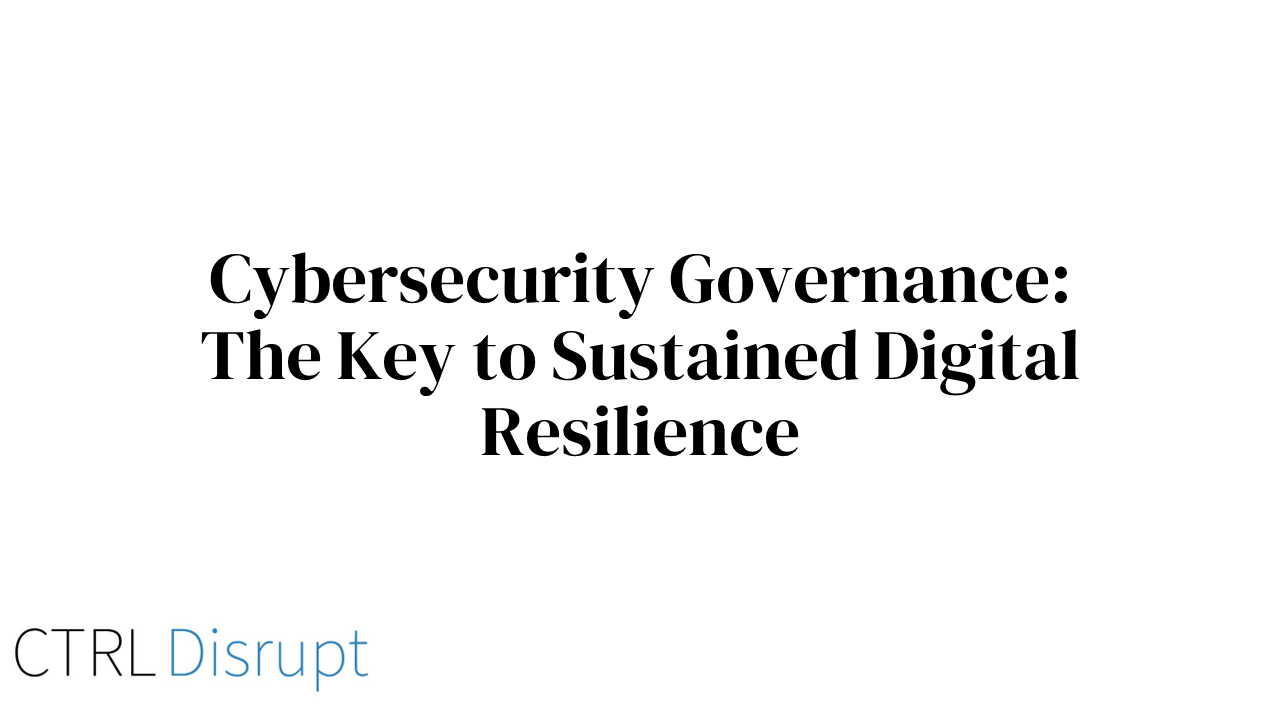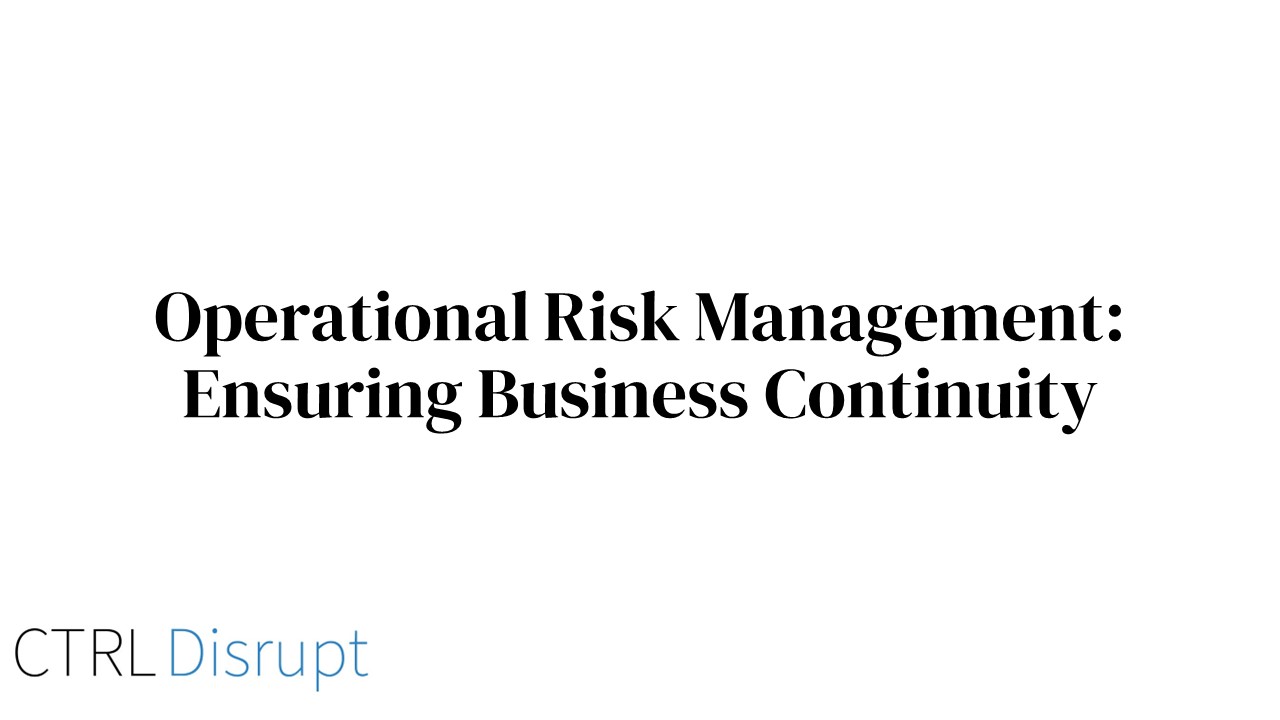GRC: The Digital Shield - Fortifying Risk Management and Compliance
Introduction to GRC in the Digital Age
As we navigate deeper into the 21st century, the backbone of business success increasingly resides in the digital realm. From the vast sprawl of e-commerce to the intricate web of data analytics, digital operations have become the lifeblood of organizational growth and sustainability. Yet, with this digital dependency comes a heightened exposure to risks that can compromise the integrity of a company's operations and its standing in the competitive market.
This reality brings Governance, Risk Management, and Compliance (GRC) into sharp focus. GRC is not just a set of isolated disciplines; it's an integrated framework that helps organizations align their objectives with their actions, manage potential risks proactively, and ensure compliance with an array of regulatory requirements.
The Growing Importance of Digital Operations
In today's business world, digital operations are no longer just support mechanisms; they are critical drivers of strategy, innovation, and customer engagement. They represent the channels through which companies interact with the world, making their performance, reliability, and security paramount. The digitalization of business has accelerated rapidly, a trend only intensified by the recent global shifts towards remote work and digital service delivery.
Overview of GRC and Its Components
GRC encompasses three main components, each contributing to the solid framework necessary for robust digital operations:
-
Governance
This is the steering wheel of the organization, ensuring that all digital initiatives align with the overall business strategy and objectives. It involves leadership, organizational structures, and the definition of roles and responsibilities. -
Risk Management
This component involves identifying, assessing, and mitigating risks associated with digital operations. It's about understanding what could go wrong and putting in place the measures to prevent those risks from becoming reality. -
Compliance
The final component ensures that digital operations adhere to laws, regulations, and policies, both internal and external. It's a complex landscape, with digital compliance covering everything from data protection regulations to industry-specific guidelines.
GRC as a Shield Against Digital Risks
In the sprawling digital ecosystem where businesses operate, risk lurks at every turn. A single vulnerability can lead to a cascade of failures, each more costly than the last. Recognizing and defending against these digital threats is not just a matter of IT security—it's a fundamental business priority. GRC provides the comprehensive armor businesses need to protect themselves and maintain their competitive edge.
Recognizing Digital Threats
The range of digital risks confronting businesses today is diverse and ever-expanding. Cyberattacks, such as ransomware and phishing, are becoming more sophisticated. Compliance missteps can lead to heavy fines and legal challenges. Operational hiccups can disrupt services and erode customer trust. In this landscape, the ability to identify these multifaceted risks and understand their potential business impact is critical.
An effective GRC framework enables businesses to anticipate these risks, evaluating them not just for their probability but also for their potential to disrupt operations. It sets the stage for a holistic risk management approach that aligns with the organization's digital ambitions and regulatory responsibilities.
The Consequences of Inadequate Digital Risk Strategies
The pitfalls of inadequate risk management are stark. A breach can compromise sensitive data, leading to financial loss and damage to reputation. Non-compliance with regulations like GDPR, HIPAA or NIS2 can result in penalties that go beyond the financial to affect brand perception. Operational risks can lead to service downtime, affecting customer loyalty and sales. The domino effect of these risks can be devastating, emphasizing the need for a robust GRC strategy.
Analysis of the Strategic Responses Facilitated by GRC Frameworks
Within the GRC domain, strategic responses are informed by a range of established frameworks, each offering unique insights and structures to guide organizations through the labyrinth of digital risks. These frameworks provide the scaffolding for organizations to construct tailored responses that are proactive, informed, and aligned with business and compliance objectives.
-
COSO Framework
The Committee of Sponsoring Organizations of the Treadway Commission (COSO) provides a model for evaluating internal controls. This framework helps organizations ensure effective governance by addressing operational, reporting, and compliance objectives. -
ISO/IEC 27001 and ISO/IEC 27005
The combination of these standards offers a robust approach to information security management and risk assessment. ISO/IEC 27001 specifies the requirements for establishing, implementing, maintaining, and continually improving an information security management system within the context of the organization. It is complemented by ISO/IEC 27005, which provides the guidelines for information security risk management. Together, they present a powerful duo for managing information security risks in a structured way. -
COBIT
Control Objectives for Information and Related Technologies (COBIT) is a framework designed by ISACA for IT management and governance. It emphasizes regulatory compliance, risk management, and aligning IT strategy with organizational goals. -
NIST Cybersecurity Framework
Developed by the National Institute of Standards and Technology, this framework focuses on using business drivers to guide cybersecurity activities and considering cybersecurity risks as part of the organization’s risk management processes.
By leveraging these and other frameworks, organizations are able to:
-
Incorporate Best Practices
Utilize industry-standard best practices and guidelines to form the basis of their strategic response to digital risks. -
Ensure Comprehensive Coverage
Address all aspects of digital risk, from technical and operational to legal and strategic. -
Adapt and Customize
While these frameworks provide a starting point, they are designed to be adaptable, allowing organizations to tailor their GRC strategies to specific risks, regulatory environments, and business models.
For example, an organisation might use the COSO Framework to ensure that its oversight and control accross risk domains are robust and mitigate risks. At the same time, it could apply the NIST Cybersecurity Framework to for the Digital risk domain to protect against cyber threats and maintain customer trust.
In essence, these GRC frameworks are not just tools for managing risk but are instrumental in shaping the strategic response of organizations to the digital challenges they face. They enable a holistic approach, ensuring that every facet of the organization's operations is considered and protected. With these frameworks, businesses can convert potential digital pitfalls into opportunities for strengthening their operations, enhancing their resilience, and ensuring sustainable success.
The Synergy of Governance, Risk Management, and Compliance
In an interconnected digital ecosystem, governance, risk management, and compliance (GRC) do not function as isolated pillars. Instead, they create a robust, interwoven framework that supports and enhances the resilience of digital environments. The synergy of these three components is pivotal in cultivating a secure, stable, and reliable digital operation for any organization.
Governance: The Guiding Principles
Governance serves as the strategic foundation of GRC, providing the framework within which all other aspects operate. It encompasses the policies, procedures, and cultural values that define an organization and its approach to digital operations.
-
Creating a Resilient Digital Environment
Governance establishes the protocols and guiding principles that lead to a resilient digital infrastructure. It is about setting the direction and tone at the top, where leadership commits to prioritizing digital resilience as a core business objective. -
Structuring Leadership and Decision-Making
Effective digital governance structures leadership and decision-making in a way that supports agility and informed action. It involves defining roles and responsibilities, ensuring clear communication channels, and establishing accountability mechanisms to support digital operations.
Risk Management: The Proactive Core
Risk management transitions an organization from a defensive posture to a proactive stance. It is about anticipating potential threats and implementing strategies that mitigate these risks before they can impact the business.
-
Proactive Versus Reactive Risk Management
Moving towards proactive risk management means embracing strategies that identify potential risks early, analyze their potential impact, and prepare responses. This approach ensures that risks are managed before they escalate into emergencies. -
Central Role in GRC
Risk assessments and mitigation strategies are at the heart of GRC. They provide the data and insights necessary to make informed decisions and prioritize actions based on potential risk to the business. This process ensures that resources are allocated effectively, focusing on areas of greatest impact.
Compliance: The Regulatory Compass
Compliance ensures that an organization’s digital operations adhere to both internal policies and external legal and regulatory requirements. It serves as the compass that guides business practices, ensuring they meet established standards of operation.
-
Navigating Complex Regulations
The digital space is fraught with a complex and ever-evolving regulatory landscape. Compliance within GRC ensures that businesses navigate these complexities successfully, avoiding potential legal pitfalls and maintaining operational integrity. -
Aligning Business Practices for Excellence
Compliance also involves aligning business practices with regulatory requirements for operational excellence. It ensures that the organization not only follows the letter of the law but also embraces the spirit of best practices in digital operations.
In summation, the synergy of governance, risk management, and compliance within GRC is essential for creating and maintaining a resilient digital environment. It is a holistic approach that ensures organizations can navigate the digital domain confidently, prepared for potential risks, and aligned with both strategic objectives and regulatory demands.
Implementing GRC in Digital Enterprises
The digital landscape demands not only innovative technologies but also strategic frameworks to manage the risks and regulations associated with them. GRC (Governance, Risk Management, and Compliance) provides a structured approach to aligning IT resources with business objectives while managing risks and meeting compliance requirements. Here's how digital enterprises can implement GRC effectively:
The Integration Blueprint
To weave GRC into the very fabric of digital strategy, businesses must follow a blueprint that is both comprehensive and flexible:
-
Strategic Assessment
Begin with a strategic assessment of current processes, identifying where GRC can be integrated to bolster digital operations. This involves mapping out current workflows, IT infrastructure, and existing risk management practices. -
GRC Framework Selection
Choose a GRC framework that aligns with the business's size, industry, and specific needs. Options include COSO, ISO frameworks, or COBIT, among others. The framework should guide the establishment of governance structures, risk management processes, and compliance controls. -
Policy Development
Develop clear policies that reflect the chosen GRC framework's principles, tailored to the enterprise's digital context. These policies should define roles, responsibilities, and procedures for governance, risk assessment, and compliance activities. -
Technology Integration
Employ GRC technology platforms that can automate and integrate governance, risk management, and compliance activities across the organization. These systems should provide a centralized view of all GRC-related data and facilitate real-time monitoring and reporting. -
Training and Culture
Implement comprehensive training programs to build a culture of GRC awareness. This ensures that all employees understand the role they play in governance, risk management, and compliance, and are equipped to act accordingly. -
Continuous Improvement
Establish a continuous improvement process for GRC activities, which includes regular reviews, audits, and updates to policies and procedures in response to changing digital threats and regulatory environments.
Best Practices in Digital Risk Management
-
Risk Identification and Analysis
Consistently identify and analyze digital risks, using both qualitative and quantitative methods. Prioritize risks based on their potential impact on business objectives and operations. -
Proactive Mitigation Strategies
Develop proactive mitigation strategies for significant risks. This could include diversifying IT systems, implementing robust cybersecurity measures, or establishing incident response plans. -
Regulatory Compliance Monitoring
Stay abreast of regulatory changes and ensure that compliance is an ongoing process, not a periodic checklist. Use GRC platforms to monitor compliance status and generate reports for stakeholders. -
Stakeholder Communication
Maintain open lines of communication with all stakeholders regarding GRC policies, practices, and status. This transparency builds trust and ensures coordinated action when addressing GRC issues. -
Leverage Data for Decision-Making
Use data analytics to inform GRC decision-making. Analyzing data trends can help predict potential risks and compliance issues before they become problematic.
By following this integration blueprint and adhering to best practices in digital risk management, digital enterprises can establish a strong GRC foundation. This foundation not only safeguards against digital risks but also ensures that business operations are conducted efficiently, ethically, and in compliance with relevant laws and regulations, thus paving the way for sustainable business growth in the digital era.
Conclusion
GRC: The Future of Digital Risk Management
As we stand at the threshold of an increasingly digitized future, the role of GRC in safeguarding the digital assets of enterprises has never been more pronounced. The convergence of governance, risk management, and compliance forms a trinity that is essential in navigating the complexities of today's digital risk landscape. The necessity for GRC is projected to grow exponentially, as it not only protects but also enables businesses to harness the power of their digital capabilities fully.
In an environment that is persistently changing, GRC stands out for its adaptive nature. It's not a static set of rules but a dynamic framework that evolves in step with new technologies, emerging risks, and shifting regulatory demands. This flexibility is the cornerstone of GRC's relevance; it allows businesses to remain agile and resilient, turning potential vulnerabilities into strengths.
Mobilizing for a GRC-Ready Future
Looking ahead, businesses are called upon to take a proactive stance in evaluating their current state of GRC integration. It's crucial to ask the hard questions: Are our GRC practices comprehensive enough to cover all digital operations? Do our governance structures support proactive risk management and compliance? Is our organization ready to respond to the digital challenges of tomorrow?
This is a call to action for businesses to not only prioritize but to elevate GRC within their strategic planning. By embedding GRC deeply into business strategies, organizations can secure a resilient digital future. They can look forward to a business environment where digital risks are managed with finesse, compliance is part of the corporate culture, and governance guides the journey towards innovation and growth.
As we embrace this digital age, let GRC be the compass that directs us through uncharted waters, ensuring that we not only navigate safely but also seize the vast opportunities that lie in our digital voyage.

 By
By


